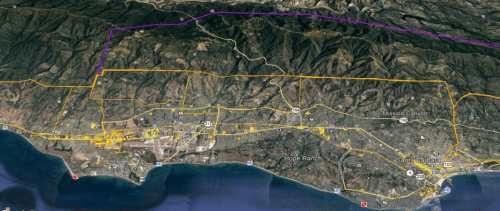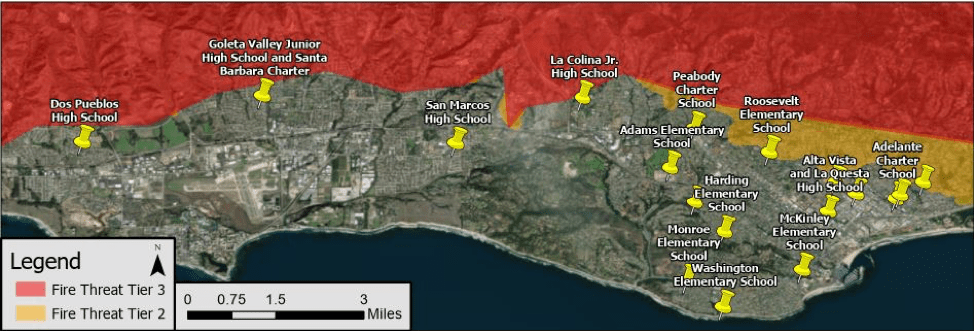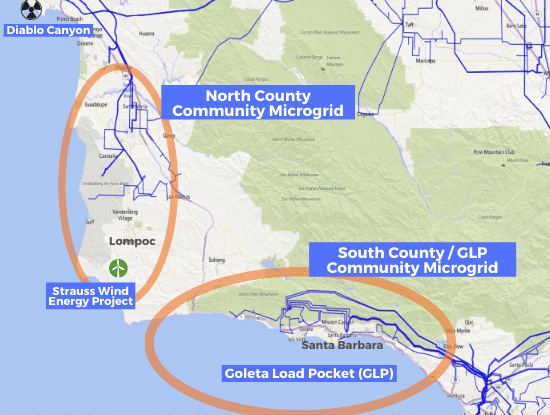
A pivotal year for the Goleta Load Pocket Community Microgrid
2020 is staged for significant development of this resilience solution, which will showcase the energy system of the future.
2019 was a year of major progress for the Goleta Load Pocket Community Microgrid (GLPCM).
The Goleta Load Pocket (GLP), a 70-mile stretch of Southern California coastline, provides the perfect opportunity to showcase the significant economic, environmental, and resilience benefits of a Community Microgrid. The GLP is disaster-prone and completely grid-dependent, getting most of its power from just one set of transmission lines that are hung on the same transmission towers and routed through 40 miles of mountainous terrain – which makes the region highly transmission-vulnerable.

The 2017 Thomas Fire and subsequent debris flow in 2018, which devastated the Montecito community – located within the GLP – highlighted the need for resilience solutions like the GLPCM.
Fortunately, the GLP has enough siting opportunity on built environments for all the solar and storage it needs to achieve indefinite renewables-driven backup power that provides it 100% protection against a complete transmission outage (“N-2 event”): 200 megawatts (MW) of solar and 400 megawatt-hours (MWh) of energy storage. This is highly achievable, representing only:
- About 5 times the amount of the solar currently deployed in the area.
- About 7% of the area’s technical solar siting potential on built environments such as rooftops, parking lots, and parking structures. This means that only 1 out of 15 rooftops, parking lots, and parking structures need to participate in hosting solar.
With the Montecito Fire Protection District’sdecision this year to work toward building a Community Microgrid for its headquarters and fire stations, and the Montecito Union School’s decision to move forward on a microgrid, the GLPCM got a good start at laying the foundation for its first building block, the Montecito Community Microgrid.
In addition, the Santa Barbara Unified School District (SBUSD) unanimously approved an ambitious initiative with the Clean Coalition and Sage Energy Consulting to stage solar-driven microgrids and electric vehicle charging infrastructure (EVCI) at schools throughout the District. The microgrids will feature solar and energy storage that can provide long-duration resilience, along with EVCI that supports District staff and students during the day – and provides overnight charging options for neighbors who have challenges installing electric vehicle chargers where they live.
The Clean Coalition and Sage Energy will conduct feasibility analyses for solar-driven microgrids and EVCI at all 18 SBUSD sites, and as determined to be feasible, followed by designing and executing a request for proposal (RFP) process to select a developer to build, own and operate the microgrids under a long-term power purchase agreement (PPA). The aim is to contract the developer by June 2020.

An initial analysis by the Clean Coalition identified over 15 megawatts of solar potential on SBUSD schools – the majority in the form of solar parking canopies. Seven of the sites are within low-income communities and could qualify for a pending enhanced energy storage incentive from the State of California that is intended to facilitate community resilience.
The anticipated PPA structure will ensure that the SBUSD is free from any upfront investments and avoids all other obligations beyond paying for delivered energy. Hence, the SBUSD will pay only for electricity delivered by the systems, at a rate anticipated to be no higher than what the District would otherwise pay to Southern California Edison.
2019 events reinforce the need for a Community Microgrid in the GLP
The Thomas Fire and Montecito Debris Flow are nearing their two-year anniversary. Since then, the GLP has continued to experience threats to its electrical infrastructure in the form of fires and Public Safety Power Shutoffs (PSPS).
PSPS events continued into late November this year, and the region experienced numerous warnings of potential events, which are disruptive even when the shutoffs don’t take place.

On November 25, the Cave Fire ignited during erratic sundowner winds that pushed flames toward communities, causing thousands of residents to be evacuated. The fire threatened the GLP’s main transmission lines and caused power outages in huge portions of Santa Barbara County.

The continued threat of fires and PSPS events in the GLP further reinforces the region’s need for a Community Microgrid.
Costs of PSPS events are massive, because these events require visual inspection of all transmission and distribution (T&D) lines that were shut down. This adds substantial costs to the already exorbitant amounts that ratepayers pay for T&D operations and maintenance (O&M). In fact, O&M costs are already so high for new transmission that they account for about 80% of the costs that will accrue to ratepayers over the lifetime of new transmission infrastructure.
The Clean Coalition’s regulatory support for the GLPCM
In September, the Clean Coalition submitted written comments and made public comments to the Santa Barbara County Board of Supervisors offering key solutions for unlocking the GLP’s renewable energy potential. These comments helped prompt the Board of Supervisors to approve the County’s Strategic Energy Plan (SEP) by a 4-1 vote.

The Clean Coalition’s comments elaborated on the need for policy and market changes to unleash solar and solar+storage on built environments in Santa Barbara County, such as:
- Changing the County’s definition of utility-scale solar.
- Amending Santa Barbara County’s Coastal Zoning Ordinance to make it easier to deploy solar and wind projects along the coast and offshore.
- Conducting a Solar Siting Survey as part of the SEP’s implementation.
- Deploying the GLPCM as a fundamental component of the County’s Energy Assurance Plan.
- Implementing a Feed-In Tariff (FIT)with Market Responsive Pricing and a Dispatchability Adder.
- Streamlining permitting for clean energy projects.
In October, the Clean Coalition filed comments with the California Public Utilities Commission (CPUC) on the rulemaking for SB 1339, a bill passed by the California Legislature in 2018 that aims to reduce barriers to resilience-focused microgrids. The Clean Coalition’s comments strategically suggested that the GLPCM be prioritized as a pilot program.
Looking ahead to 2020 and beyond
As 2019 comes to a close, the Clean Coalition is continuing our work to ensure that resilience for the GLP is achieved via renewables-driven Community Microgrids – and to preempt any proposed gas peaker infrastructure.
Southern California Edison has already made major progress toward shifting away from new gas peakers by proposing 280 megawatt-hours (MWh) of energy storage within the GLP through their Local Capacity Requirements Request for Proposals. These 280 MWh represent around 70% of the 400 MWh needed to provide the GLP 100% protection against a complete transmission outage. The energy storage projects being solicited have expected commercial online dates of late 2020 or early 2021. The Clean Coalition has expressed support for these projects and will continue to align the stakeholders needed to get the projects approved.
The Clean Coalition has also begun to focus on the northern portion of Santa Barbara County, which shares the GLP’s need for resilience – and also needs new generation sources to bolster the region for the impending closure of the Diablo Canyon Nuclear Power Plant in 2025. The Strauss Wind Energy Project (SWEP), which the Clean Coalition supported along with numerous other parties, will provide the backbone of the energy resilience needed in the North County, reducing reliance on vulnerable long-distance transmission lines by introducing significant local energy resources. The SWEP, which will enable the same amount of energy generation that is anticipated across hundreds of sites for the GLPCM, offers the perfect opportunity to stage a North County Community Microgrid.

The first microgrids for the GLPCM, within the Montecito Upper Village, are currently going through an RFP process, with construction expected to start sometime in 2020. Next year is shaping up to be an exciting year for the GLPCM, which will provide a model for Community Microgrids that can be followed throughout California and beyond.
For more on the GLPCM, see our previous blog posts:

